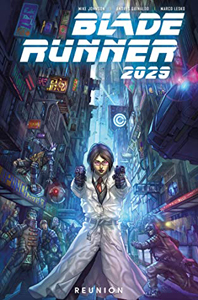With “Blade Runner 2029: Volume 1 – Reunion” (Issues 1-4, 2021), Titan’s “Blade Runner” saga drops from outstanding down to great; I suppose the high level can’t be maintained forever. The previous volume – “2019: Volume 3” – hinted at the unusual notion that replicants would be so clearly morally superior to humans that humans would face tough “look in the mirror” questions.
A wall between them
“Reunion” backs off on that theme to metaphorically explore more familiar ground. The replicants now stand in for Mexican immigrants, and a Seawall around Los Angeles (necessary because of rising ocean levels) stands in for Trump’s border wall. In the big picture, these issues comment on the USA’s current messy and fear-driven immigration and amnesty policies.
I like the Seawall; it’s something Philip K. Dick might’ve come up with if politicians of his time were harping for border walls. It’s a ridiculous yet grand monument to power for power’s sake, especially when the metal monstrosity is portrayed by artists Andres Guinaldo (pencils and inks) and Marco Lesko (colors).

“Blade Runner 2029” Issues 1-4 (2021)
Subtitle: “Volume 1: Reunion”
Writers: Mike Johnson
Art: Andres Guinaldo
Colors: Marco Lesko
Mike Johnson is now the lead writer, and fellow “2019” scribe Michael Green (who also co-wrote “Blade Runner 2049”) is merely a creative consultant. “2029” is still smartly written, but I notice more holes.
Ash, the former blade runner who now uses her hunting skills to secretly help replicants, is inexplicably employed by the LAPD again. She was nearly imprisoned last time around, and I’m not sure why she’s free, let alone back in their good graces. I’m reminded of how “The X-Files’ ” Fox Mulder always somehow kept his FBI job no matter how many people he ticked off – so I guess I’ll allow it here too.
A helpful ally pops up late, and Ash knows him but he hadn’t been introduced to readers. In these ways, “2029” is a little less tight than “2019.”
Replicant biology
On the plus side, Johnson broaches a part of the lore that has been tantalizingly beyond the surface: the biology of replicants. The revolutionaries are led by a Nexus-6 who inexplicably lived beyond his four-year lifespan. He gets further extended life thanks to blood transfusions from his loyal Nexus-8 followers.
This miraculous Nexus-6, named Yotum, oversees vats containing Nexus-8 bodies salvaged from the Tyrell ruins (as seen in “2019”). So assembly line production has ended, but the world could soon be flooded with Nexus-8s.
That’s solid world-building, but “2029’s” world creation especially comes via Guinaldo and Lesko. I always feel like I’m in the “Blade Runner” future.
Haves vs. have-nots
This volume particularly focuses on rich people who promoted anti-replicant laws because of xenophobia yet also employ replicants as servants. We see a gilded bedroom so large that one climbs stairs to the bed, and the door is a mere speck in the distance. Nothing but a golden floor fills the intervening space.

Johnson uses “Reunion” to thoroughly firm up the metaphor: Humans are the rulers and replicants are the slaves. (This has always been a metaphor in “BR,” granted, but not so bluntly before this.)
Ash is physically in between because of her robotic spine and emotionally in-between because she has a replicant girlfriend. (And more broadly, like Deckard, her job has forced her to realize that there’s no substantial difference between humans and replicants.)
But generally this volume emphasizes binary positions rather than nuance. “Blade Runner 2029: Volume 1” is well worth reading, but it has become thematically simpler than “2019.” This might be a concern as the story continues.

